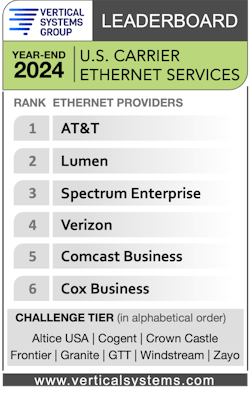AT&T’s lead in U.S. carrier Ethernet faces challenges from Comcast Business, Spectrum Enterprise
Here’s more coverage of other key stories on Ethernet and business services:
- AT&T continues its U.S. Ethernet dominance
- Lumen is driving network expansion to build the backbone of the AI economy
- Comcast Business’ revenue base is approaching $10 billion.
- Comcast Business’ Nitel acquisition enhances its managed networking capabilities
- VMware takes over the top spot from Cisco on VSG’s SD-WAN technology LEADERBOARD
AT&T continues holding its top position as the dominant Ethernet provider in the U.S., according to Vertical System Group’s 2024 U.S. Carrier Ethernet LEADERBOARD.
Still, cable operators aggressively expanding their base will continue threatening telcos' hold on the market.
Despite its growth in Ethernet, AT&T continued to see challenges in its Business Wireline segment.
During the fourth quarter, Business Wireline revenues declined 10%, and EBITDA was down 22%, primarily due to what Pascal Desroches, AT&T's CFO, said were “continued industry-wide secular declines in legacy services.”
As seen in earlier periods, AT&T was joined by Lumen, Spectrum Enterprise, Verizon, Comcast Business, and Cox Business as the top Ethernet providers on VSG’s LEADERBOARD.
Service providers must have 4% or more of the U.S. retail Ethernet services market.
DIA, gigabit growth
Led by demand for dedicated internet access (DIA) connections, Ethernet services continued to grow throughout 2024.
Overall, the total U.S. base of retail Ethernet ports grew 2.2%.
Ethernet DIA is forecast to increase at a double-digit CAGR between 2024 and 2029.
Likewise, gigabit speed services are powering the expansion of the U.S. Ethernet market and propelling demand for new fiber deployments.
Various applications, such as AI and GenAI, plus Cloud, Data Center, and Managed SD-WAN/SASE services, which all need Ethernet connectivity, are driving this growth.
Rick Malone, principal of Vertical Systems Group, said while the overall U.S. Ethernet grew, “other segments--including Access, Private Lines and Metro—are in secular decline.”
“The U.S. Ethernet market continues to expand despite its legacy status,” he said. “We project sustained slow growth through 2029 driven by customer requirements for DIA services.”
Cable’s growing threat
Cable operators continue to see growth in the business and Ethernet services segment.
Spectrum Enterprise and Comcast Business were the only LEADERBOARD companies with Ethernet port share gains in 2024.
These providers saw strong business service results in the fourth quarter.
Comcast reported that, due to increased revenue from enterprise solutions offerings and small business customers driven by higher average rates, Business Services Connectivity revenues in the fourth quarter rose 3.7% year over year to $2.45 billion.
What’s compelling is that Comcast sees multi-billion opportunities for the business sector. \
Comcast's CFO, Jason Armstrong, said, “Business Services has been growing at an industry-leading mid-single-digit rate, with a total revenue base approaching $10 billion.”
The cable MSO continues to see opportunities to scale the business sector. In December, Comcast Business announced it would acquire network-as-a-service (NaaS) provider Nitel, deepening its cloud-based network capabilities.
Likewise, Spectrum Business saw continued business services growth during the Q4 earnings period.
Charter reported that commercial revenue grew by 1.9% year-over-year, with SMB revenue growth of 0.3%, reflecting higher monthly SMB revenue per SMB customer primarily due to rate adjustments. Enterprise revenue grew by 4.4%, driven by enterprise PSU growth of 5.2%. The cable MSO has the potential to continue to scale its Ethernet and overall business services portfolio by leveraging its over 300,000 fiber-lit buildings.
Challengers rising
Besides cable’s ongoing movement, VSG noted that the Challenge Tier is also evolving.
The Challenge Tiers include Altice USA (including Lightpath), Cogent, Frontier, Granite, GTT, Windstream, and Zayo. This segment contains providers with a 1% to 4% share of the U.S. retail Ethernet market.
The Challenge Tier expanded to eight providers as Crown Castle advanced from the Market Player tier.
While Crown Castle has not announced the date of its fourth-quarter earnings yet, the service provider saw growth during the third quarter in its fiber solutions business, which serves businesses.
Crown Castle’s CEO, Steven Moskowitz, attributes its growth in the fiber solutions business to operational changes it made to the business segment and the fact that it works with customers to identify on-net and near-net fiber opportunities.
“This strategy enables us to grow revenues with reduced capital investment compared to previous years. Since implementing these operational changes in June, we've been encouraged by the early results,” he said during the company’s third-quarter earnings call. “In the third quarter, we delivered 2% organic growth, excluding $4 million of prior period revenue adjustments, and we expect to deliver 2% growth for the full-year 2024, excluding the impact of some Sprint cancellations.”
For related articles, visit the Business Topic Center.
For more information on high-speed transmission systems and suppliers, visit the Lightwave Buyer’s Guide.
To stay abreast of fiber network deployments, subscribe to Lightwave’s Service Providers and Datacom/Data Center newsletters.
About the Author
Sean Buckley
Sean is responsible for establishing and executing the editorial strategies of Lightwave and Broadband Technology Report across their websites, email newsletters, events, and other information products.



